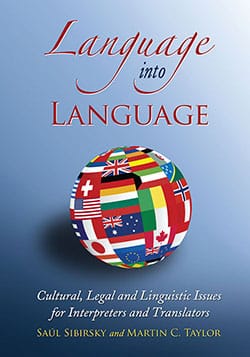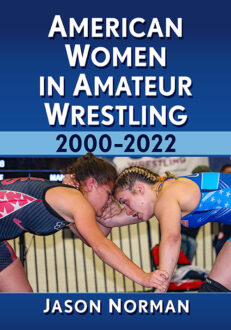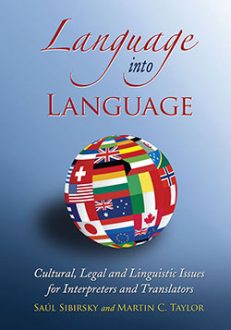Language into Language
Cultural, Legal and Linguistic Issues for Interpreters and Translators
Original price was: $39.95.$31.99Current price is: $31.99.
In stock
About the Book
Language into Language, conceived as both a theoretical and a practical source for aspiring and practicing interpreters and translators, also serves courtroom personnel (judges, attorneys, and reporters) and social-service administrators, as well as language teachers, diplomats, and business executives who are involved in bilingual and bicultural environments and language transactions.
Instructors considering this book for use in a course may request an examination copy here.
About the Author(s)
Bibliographic Details
Saúl Sibirsky and Martin C. Taylor
Format: softcover (7 x 10)
Pages: 254
Bibliographic Info: notes, bibliography, index
Copyright Date: 2010
pISBN: 978-0-7864-4811-1
eISBN: 978-1-4766-2276-7
Imprint: McFarland
Table of Contents
Acknowledgments vii
A Note from the Authors xiii
Preface 1
PART I: LEGAL, PROFESSIONAL, ETHICAL, EDUCATIONAL, AND ECONOMIC ISSUES
1. Introduction
A. A Brief Overview 5
B. The Authors’ Aspirations 7
2. Historical Perspectives from the New World
A. Communication and the Military 9
B. The Americas: Language Follows the Flag 9
3. Language and the Legal Systems
A. Federal Court Interpreters Act 13
B. Justice for the Limited-in-English Proficiency (LEP) 15
C. English-Only Statutes, Challenges, and the LEP 16
D. The “LEP” Controversy 19
4. Need for Adequate Interpretation and Translation
A. Are Interpreters Interlopers? 21
B. Language Mistakes 22
C. Ad Hoc or Stand-In Interpreters 22
D. Interpreters Bridge the Gaps 25
E. Consequences of a Lack of Interpreters 25
5. Professional Standards
A. Ethical Conduct 27
B. Expectations of Professionals 29
C. NAJIT’s and SDNY’s Codes 30
D. The Interpreter’s Role in Unfair Situations 32
E. Ethics, Meta-Ethics, and Postville 34
F. The Judicial System and Science 37
6. Professional Qualifications
A. Interpreting Day by Day 39
B. Journal of an Itinerant Interpreter 40
C. Neutrality and Decorum vis-à-vis Misfortunes 42
D. Physical and Emotional Conditioning 43
E. Professional Qualifications Defined 45
F. Minimal and Desirable Characteristics 46
G. Defending Professional Standards 47
7. Training, Testing, and Certification
A. Colleges/Universities: U.S., Canada, and Other Areas 51
B. California 54
C. Arizona and South Carolina 55
D. Medical Interpreting in English-Only States 56
E. Florida 57
F. Sign Language: D.C. and Arkansas 58
G. Tests and Testing 58
H. Certification 61
I. Self-Directed Competency 66
J. Additional Research Resources 69
K. A Debate: Ortega and the Necessity and Sufficiency of Training 71
8. Economics, Jobs, Salaries
A. Skills vs. Economic Worth 74
B. Government Agencies 76
C. Federal and State Courts 78
D. Private Sector Opportunities 83
E. Journals with Jobs 84
F. Networking at Conferences at Home and Abroad 85
G. Private Employment Agencies 85
H. Salary Surveys and ATA’s Role 89
PART II: INTERPRETATION AND TRANSLATION IN CULTURAL, LEGAL, AND LINGUISTIC CONTEXTS
9. Comparing Interpretation and Translation
A. Formal Definitions 95
B. Operational Definitions 96
C. Philosophical Definitions 96
D. Guide to Classified Definitions 97
E. Desirable Characteristics in Interpreters 105
F. Traits of Successful Translators 106
G. Machine Translators vs. Human Translators 106
H. Translators and Interpreters in/of Literary Texts 108
10. Decoding and Encoding Multidimensional Language
A. Interpretation as Communication 112
B. Triangular and Multidimensional Interpretation 114
C. The Speech-Chain Bridge and Diagram 116
D. Memory in Storing and Decoding “Units of Meaning” 117
11. Modes of Interpretation and Translation
A. Overview of the Modes 120
B. The Summary Interpretation Mode (SummI) 121
C. Consecutive Interpreting (CI) 121
D. Simultaneous Interpreting (SI) 125
E. Whispered SI, or Chuchotage, in Diplomacy 129
F. Interpreters as Scapegoats 130
G. Conference Interpreting (ConfI) 131
H. Sight Translation (ST) 133
I. Guidelines for Improving Performance 134
12. Verbal and Nonverbal Equivalencies in the Courtroom
A. Searching for Verbal Equivalency 135
B. Strategies for Finding Equivalencies 144
C. Equivalencies via Grammar or Linguistics 146
D. Nonverbal Equivalencies or Gestures 148
13. Settings and Procedures in Legal and Social Venues
A. Existential Aspects of Interpretation 151
B. Factors that Affect the Settings 151
C. Classification of the Settings 152
14. Playacting and Power Relationships in the Courtroom
A. Interpreters as Actors 170
B. Roles of the Other Players 172
C. Varieties of Power 177
D. Power Misplaced 180
E. The Power of Excellence and Modesty 186
15. Implications of Bilingualism
A. Defining Bilinguals and Bilingualism 188
B. Bilingual Interpreters and Translators 190
C. Code-Switching Patterns of Bilinguals 191
D. LEPs and Other Second-Language Learners 193
E. The Brain and Second-Language Learning 195
F. The Bilingual Education Act 197
G. Political, Cultural, and Security Aspects 198
16. Cultures and Languages in Play
A. Cultural Possibilities 201
B. Culture and Interpretation 204
C. Words Transmit and Distort Culture 207
D. Alternative Cultural Perspectives 212
Chapter Notes 219
Author and Works Cited 228
Suggested Readings 233
Index 235
Book Reviews & Awards
“exceptionally well written…strongly recommended”—Midwest Book Review; “solid…excellent compendium…a one-stop reference…highly recommended”—Proteus.






